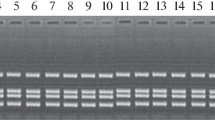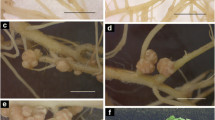Abstract
A field isolate of Bradyrhizobium japonicum which failed to attach polarly or firmly to soybean roots was compared with the laboratory isolate I-110 for its relative rate of growth, piliation, attachment and nodulation. Both isolates grew at a comparable rate in yeast extract-gluconate medium as well as in soybean root exudate, produced comparable amounts of soybean lectin binding polysaccharide, infected through curled root hairs and developed effective nodules. Approximately 5% of cells in cultures of 110 possessed pili but none were detected in cultures of 1007 by electron microscopy. Light microscopic observations of root hairs from roots exposed to 1007 and 110 inoculum showed no polarly attached cells of 1007 and approximately 100 cells of 110 polarly attached per mm root hair length. Plate counting of firmly bound cells released by sonication indicated that the number of 1007 cells firmly adhering was at least 1000-fold lower than the number of 110 cells attached. The significance of polar, firm and weak attachment in the initiation of symbiotic interactions is discussed.
Similar content being viewed by others
References
Bauer WD (1981) Infection of legumes by rhizobia. In: Briggs WR, Green PB, Jones RL (eds) Annual review plant physiology, vol 32. Annual Reviews Inc, Palo Alto, pp 407–449
Bhuvaneswari TV, Bauer WD (1978) Role of lectins in plant-microorganism interactions. III. Binding of soybean lectin to root cultured rhizobia. Plant Physiol 62:71–74
Bhuvaneswari TV, Mills KK, Crist DK, Evans WR, Bauer WD (1983) Effects of culture age on symbiotic infectivity of Rhizobium japonicum. J Bacteriol 153:443–451
Bhunvaneswari TV, Turgeon BG, Bauer WD (1980) Early events in the infection of soybean (Glycine max L. Merr) by Rhizobium japonicum. I. Localization of infectible root cells. Plant Physiol 66:1027–1031
Bidwell VA, Bartlett A (1979) The enzyme linked immunosorbent assay (ELISA) A guide with abstracts of microplate applications. Dynatech Europe, Germany, pp 1–39
Bohlool BB, Schmidt EL (1976) Immunofluorescent polar tips of Rhizobium japonicum: possible site of attachment of lectin binding. J Bacteriol 125:1188–1194
Calvert HE, Pence MK, Pierce M, Malik NSA, Bauer WD (1984) Anatomical analysis of the development and distribution of Rhizobium japonicum infections in soybean roots. Can J Bot 62:2375–2384
Costerton JW, Geesey GG, Cheng KJ (1978) How bacteria stick. Sci Am 238:86–95
Dazzo FB, Hubbel DH (1975) Cross reactive antigens and lectin as determinats of symbiotic specificity in the Rhizobium-clover association. Appl Environ Microbiol 30:1017–1033
Dazzo FB, Brill WJ (1977) Receptor site on clover and alfalfa root for Rhizobium. Appl Environ Microbiol 33:132–136
Dazzo FB, Napoli C, Hubbell DH (1976) Adsorption of bacteria to roots as related to host specificity in the Rhizobium-clover symbiosis. Appl Environ Microbiol 32:166–171
Isaacson RE (1985) Pilus adhesins. In: Savage DC, Fletcher M (eds) Bacterial adhesion. Mechanisms and physiological significance. Plenum Press, New York London, pp 307–338
Law IJ, Yamamoto Y, Mort AJ, Bauer WD (1982) Nodulation of soybean by Rhizobium japonicum mutants with altered capsule synthesis. Planta 154:100–109
Marshall KC (1985) Mechanisms of bacterial adhesion at solidwater interfaces. In: Savage DC, Fletcher M (eds) Bacterial adhesion. Mechanisms and physiological significance. Plenum Press, New York London, pp 133–162
Matthysse AG (1985) Mechanisms of bacterial adhesion to plant surfaces. In: Savage DC, Fletcher M (eds) Bacterial adhesion. Mechanisms and physiological significance. Plenum Press, New York London, pp 255–278
Pueppke SG (1984) Adsorption of slow-and fast-growing rhizobia to soybean and cowpea roots. Plant Physiol 75:924–928
Streeter JG (1974) Growth of two soybean shoots on a single root effect on nitrogen and dry matter accumulation by shoots and on the rate of nitrogen fixation by nodulated roots. J Exp Bot 84:189–198
Van Rensberg HJ, Strijdom EW (1982) Root surface association in relation to nodulation of Medicago sativa. Appl Environ Microbiol 44:93–97
Vesper SJ, Bauer WD (1985) Characterization of Rhizobium attachment to soybean roots. Symbiosis 1:139–162
Vesper SJ, Bauer WD (1986) Role of pili (fimbriae) in attachment of Bradyrhizobium japonicum to soybean roots. Appl Environ Microbiol 52:134–141
Vesper SJ, Malik NSA, Bauer WD (1987) Transposon mutants of Bradyrhizobium japonicum altered in attachment to host roots. Appl Environ Microbiol 53:1959–1961
Author information
Authors and Affiliations
Additional information
Dedicated to the menory of Harry E. Calvert
Rights and permissions
About this article
Cite this article
Vesper, S.J., Bhuvaneswari, T.V. Nodulation of soybean roots by an isolate of Bradyrhizobium japonicum with reduced firm attachment capability. Arch. Microbiol. 150, 15–19 (1988). https://doi.org/10.1007/BF00409711
Accepted:
Issue Date:
DOI: https://doi.org/10.1007/BF00409711




